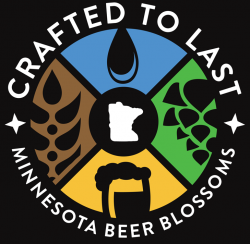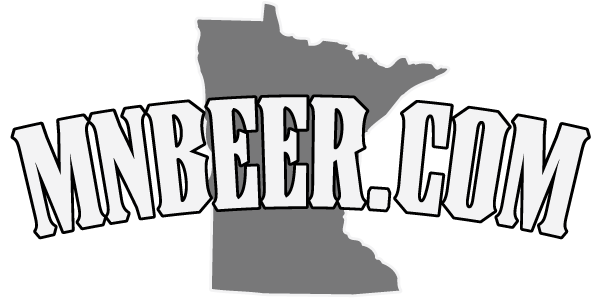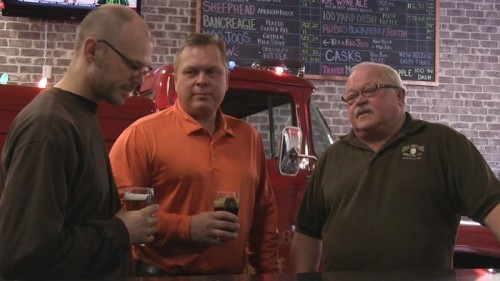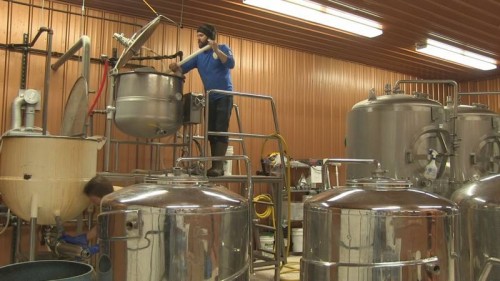 Crafted to Last Minnesota Beer Blossoms is a long format documentary from Minneapolis film maker Dave Okar. Okar began to document the boom in February 2012, eventually recording at 16 breweries across the state.
Crafted to Last Minnesota Beer Blossoms is a long format documentary from Minneapolis film maker Dave Okar. Okar began to document the boom in February 2012, eventually recording at 16 breweries across the state.
In the film, people from all of these breweries talk about beer, breweries, history, family, law, and many other topics. The audio track weaves all of these voices together to tell the story of Minnesota brewing. It is historical and contemporary. Patrick Curme sat down with Dave for great interview. Read on. Thank you to Dave and Patrick!
Okar’s film debut’s Saturday in Minneapolis and on the 25th in Duluth. Scroll down for tickets and information.
Q: Dave, tell me about the operation behind Crafted To Last… who do you have working on it?
Dave Okar: I’m not kidding when I say it’s a homebrew film, because that’s really how I feel. It’s pretty much just me, and my buddy who’s a bit more gregarious and outgoing and my wife taking still shots. But other than that, and adding in Zack (Lozier, film score musician) now, it’s pretty much all me.
Q: Did you have an idea about what kind of feeling you wanted for the film score before you pulled in Zach Lozier?
DO: It was a really collaborative process, working with Zack. For example, when we were talking to Ted Marti (Schell’s), we wanted a certain mood, just so that we wouldn’t be putting everyone to sleep (laughter), but I wanted certain parts to have a certain feeling. Zack knows Jason and Jesse from Harriet Brewery, and he really liked the film and thought it was a great story, and liked the opportunity to flesh out his ability and compose for it… I basically gave him a copy of the film so that he could get a sense of how it flows and what music fits and he gave me a few pieces and we tried it out… we went round and round, but for the most part what he gave me really worked well. We did want to make things interesting, have the music stand alone no matter what part of the film you’re watching… and it really does stand alone.
Q: I’m wondering what your relationship with craft beer and especially MN craft beer is, independent of your experience making the film.
DO: Well… I like good beer (laughs). I love craft beer, I came to what you would call craft beer, though I don’t think it was the term back then, but I came on through Belgian farmhouse ales. Back when I moved to the Twin Cities in 1993, I was drinking a lot of Bass ale, and sometimes they didn’t have Bass, but they’d say ‘Well, why don’t you try this Summit Extra Pale Ale’, and oftentimes it was better than the Bass, because it was fresher, and so somewhere in there I just switched over and put away the Bass and just started drinking the Summit. I have family in Portland, Denver, California and Michigan, so I just started getting a sense that there was local beer around in all those places, in MN, Fitger’s was first off for me….
Q: … And that was the impetus to make this film?
DO: Yeah, well, more recently, in November 2011, my wife and I were driving back from visiting family in Michigan, and we stopped in Chicago to see a friend. We were drinking nice local beer, eating local cheese, and talking about everything- it was right around when the new laws came into effect (the ‘Surly bill’), so that was a topic of conversation, at the time I was pretty much losing my job (laughter)… I mean, I worked for the Federal Government and I was running a biochemistry research lab with the V.A. for about 20 years, and since everything runs slowly with the Federal Government, I could see the writing on the wall, and the money wasn’t that great, though the work was fascinating. Anyways, somewhere along the drive in between Chicago and Minnesota during that long stretch of land in Wisconsin where there’s nothing but cranberries, we were talking about it and I was mouthing off about how someone should be documenting this unique opportunity, this moment in MN beer history.
So she said, ‘Why don’t you just get a camera and do it’ and so I decided to go for it, looked up all the breweries in MN and sent out letters to all of them asking if they wanted to be in the film.
Q: How was the response? Pretty high?
DO: No, not necessarily. Everyone’s so busy, so for a number of breweries that didn’t show up in the film, we’d set some time and it just wouldn’t work out, and I realized that I’m not just some big filmmaker coming in. That said, I did get a lot of people to participate.
Q: There’s also not a lot of craft beer documentaries. As you’ve noted in another interview, that was a pretty open field.
DO: I think Beer Geeks did something on the collaboration between Northbound (Smokehouse and Brewpub) and Indeed for the Hotbox beer, and that’s actually a big part of my film, and that’s a whole story… there’s always a thing between brewpubs and taprooms, and I didn’t realize how big a thing it was before I started talking to people, so I thought it was nice how they got together, how that beer came to be. They both came from Town Hall (brewers Jaime Robinson and Josh Bischoff), from Mike Hoops, and here’s two people who came from him- one to a brewpub and one to a brewery- and now they’re figuring out a way to work together to make a beer and distribute it, and I thought that was just wonderful. Through that beer, they’re able to bring the two together, and they’re both coming from a guy (Hoops) who’s experienced a lot of stuff in his day- how brewers come in, they get some experience, and they leave to work at a brewery. So I really like that part of the film, and plus, its an awesome beer!
Q: You feature a whole range of different brewers and owners in this film who utilize different models and scales… Everyone from Joe Pond from Olvalde Farms Brewery to Omar and Todd from Surly. Did you notice any differences in their approach to brewing and how they handle the day to day tasks and their brand management, other than the differences in their distribution output and size?
DO: You know, that was one of the more surprising things that I learned doing this. I thought there would be about 3 or 4 models to manage a brewery and get it started, but as I learned, it seems there’s as many ways to get a brewery going than there is styles of beer, and that’s kind of the two ends of the spectrum- Joe from Olvalde and Omar and Todd from Surly. And of the people I’ve talked to, the biggest was Ted Marti from Schell’s, and that’s an outstanding part of the film, but a lot of the older breweries like Schell’s and Flat Earth, back in the day when you got going, you had to aim big otherwise you weren’t going to make it. And Surly is on a whole other track, and Joe is on the other end of that spectrum, and he admits that. And a quote that I got from him is that ‘no one else in the industry approaches things the way I do’, and when he’s talking about his brewery in Rollingstone, MN, he just wants to blend in. He wants people to drive by the farm and not realize that there’s a brewery there.
Yet somehow that entire spectrum of people, and initiatives, and different ways of doing it all seem to be doing pretty well right now, so that’s really encouraging to me. It isn’t condensed down to some one-size business model, you can make a difference in the style that you want to. And for example, I met with the guys from Lucid and Badger Hill who figured out the alternating proprietorship model, where you can share bottling lines and fermenters and space, so there’s another route. And Jon (Messier, Lucid Brewing co-owner) and his two kids are in the film for a second, which was really cool and he has a lot of nice things to say… subsequently, Jon has said that they view their brewery as an incubator for other breweries looking to start up, maybe alleviate some of their start-up costs.
Q: You feature a number of time lapse sequences of breweries in the film. Why did you decide to use that technique and what did it bring to the film?
DO: Well, first off, I majored in Biochemistry with a minor in Quantum Mechanics, and I have a PhD in Chemistry. So I’ve always been interested in the concept of time and how we relate to it, and how most of us view time as linear, but when you see time lapse shots of satellite imagery or nature shots, it really gives you a new perspective.
I did time lapse shots at Dangerous Man and I met with Rob and Sarah (from Dangerous Man) and they were literally sitting in an empty building before the brewery was built, with holes in the wall and everything, and then it shows the progression of the empty building to them serving beer. Same thing with Harriet Brewing, which really worked well. So I think it adds a difference dimension of all the work that goes into creating a brewery.
Q: You’ve said that Crafted to Last is for everyone- beer aficionados and novices alike- but what are some things that beer novices might find interesting or fascinating?
DO: The main thing that people who aren’t necessarily into the local beer scene will get from the film is just how passionate and thoughtful the people who are doing it are and how much effort they put in. If you don’t homebrew or don’t know about brewing and you just go to the store and pick something off the shelf, you might not know how much work and thought went into that. Especially if you’re not a craft beer drinker, you walk through the store now and see all the different names and styles, and you don’t know what is what. I know lots of people who are Bud drinkers, and they stick by their Bud, and they see all the new craft stuff and they kinda think it’s a scam, like maybe they’re putting different labels on the same beer then trying to sell it to you (laughter). So for people like that to understand how much thought and effort and really tremendous passion went into what they’re doing is important. It’s not that different from people who are into local foods and urban farming, they’re all going to connect to these stories.
Q: You mentioned that you started on this around the time the Surly laws were passed. How does that period figure into the film?
DO: Well, Omar and Todd are in the film, and when they started in 2006, his big concern about whether the state could support two craft breweries, and now with the new destination brewery there’s going to be 4 breweries within two miles, so the whole scene has really changed since the time that they started their business plan. They got into the whole Surly bill so that they could build their destination brewery, and it was surprising to them that it would allow a bunch of new breweries to start up and open up opportunities for them. They really didn’t consider that result, they were only focused on executing their goal to open up that brewery and nothing else, but if it forces them to compete and be a better brewery, that’s great, and I think they feel the same way.
Q: So a rising tide lifts all ships, essentially?
DO: Yeah! There’s a phrase they (the Brewers/Owners) throw around, ‘it’s all about the beer’, but it isn’t all about the beer. There’s a lot of public policy and economic considerations that go into this industry. And this sector of our economy isn’t going away- not just craft beer, but other related industries. It’s going to stay because there’s enough people interested in it. It also has so positively affected all their local businesses, from the local stores around these places to the farmers, with hop farms now- this year the big thing is that they are popping up- and I don’t think it will be long before we see some specialty malt houses going up, because that’s one of the advantages that we have over the coasts from living in this area of the country, we have cold, dry winters, which is perfect if you’re going to malt,… but I really think that’ll all be taking off in the next couple years.
Q: In your view, where is the Minnesota craft beer scene positioned in the national picture? What are we all about? Who are we?
DO: Now I’m not a native Minnesotan, but the thing that intrigued or surprised me was how many people I knew that are from MN, who went away for one reason or another, and then came back and love it here. I grew up outside Detroit, Michigan, and no one ever came back there, and I’m never going back! (laughter) … unless you force me. And California, the sense I get there is a lot of people who came from other places. So the main thing that I get from Minnesota is a sense of place, this is their home, and relatedly, I think that’s why the brewers connected so easily with the idea of making a beer that’s all from Minnesota. And it started with Joe (Pond, owner of Olvalde Brewery), but I think every brewer I talked to thinks it’s a great idea, and even the guys from Surly would say, ‘yeah, it’s a great idea, but we make so much beer that’s there’s no possible way we could get everything from MN’, but I’m sure if someone could meet their demand, I’m sure they’d welcome it! I think Minnesota, particularly among the Midwest region, coming from places where people don’t want to go back to, it’s really interesting to live in a place where people want to come back… I’ve never been in a place like that til I came here.
I think that if there’s anything that makes MN stand out in a national or world scene, it’s gonna be that. People are just happy to be in this place, and they don’t want to screw it up, because they live here and their kids are probably going to live here. There’s a sense of home. And that’s why we’re still here 20 years we moved here and happy as ever.
Q: The release party for Crafted To Last is coming up next month on July 19th at the Parkway Theatre in South Minneapolis. You recently extended the crowd sourcing campaign on Indegogo, with the intent to pay the musical artists that worked on the score and the artists that might play the opening party. What do you have in mind for the party?
DO: Well, my intent with the Indegogo campaign was not to give me money, or anything, but a lot of the films and docs that people are pushing on there want money to get things started. In this case, I couldn’t wait… if I would have waited for proper funding, the moment I was trying to document would have been passed, so I decided to just get in there and do it, and that’s the way I go after things anyway, “go do it and see how it happens”, maybe not the most professional way to go about it, but whatever! (laughs). But I have the skills and I’m good enough at what I do that I knew I could make a quality product in the end.
As for the opening, I want it to be a big event. By that time, this will be almost 2.5 years, so for me, it’s a big moment, a big release. So I wanted to have the music, and some great beer and food, but it would certainly nice to get some money flowing back in! But it’s going to go ahead no matter what. But I just want to get our community in for that, show them what we have, and then maybe I can make some mark. I’m so thrilled that I could get Willy Murphy to play, because he doesn’t do this sort of stuff,… For a long time I hosted an open mic night in MPLS, and through that I got into touch with a lot of artists and singer/songwriters. But it just kinda bugs me that there’s a lot of artists and writers here that are so talented and can do so many things and they’re not financially respected for that, so I just made a commitment to the musicians and Zach (Lozier) who was ready to do it for free, to compensate him, and I’m going to, and I hope all the members of the community will compensate him as well.
Q: Are you taking Crafted To Last around to different venues after the opening?
Yes, well, short answer is that is the plan. We are confirmed for July 25th at the Zeitgeist theatre in Duluth which is a day before the All Pints North festival in Duluth. I spoke to the people organizing that event, and they’re going to do some promoting for me, and I scheduled the time at the theatre and they’re having their Craft Brewers business meeting that night at Tycoons, and it should be over by 8:30 and the film starts at 9 at the Zeitgeist. It’s a relatively small theatre, about 100 seats, but my idea was to have an opening night tour, start in Minneapolis, my adopted hometown, go to Duluth- a very distinct place in terms of craft beer- and then try and match the geographic range of the film, by going North/South/East and West. Pretty much every brewery I went to, whether featured or not, said ‘yeah, bring it over here, we’ll show it in the brewery.’
Q: Were there breweries who wanted to make it in but didn’t have a chance? Will there be a Crafting To Last 2?
DO: Yes, there are breweries that I wish I could have worked in, and others who we just couldn’t get together, like Fulton and Summit, we tried hard but it didn’t work with our schedules. But since then, people heard about it and really wanted to get in, but we weren’t able to or it was too late. I wish I could have done something with Dayblock. Paul Johnson is the head brewer there and we met at Harriet and I knew him when he was at Lucid, but the timing just didn’t work. Same with Bent Paddle, they just didn’t have time b/c of their opening, and then I didn’t have time.
On Part 2… I’m not interested in part 2 at this point. There are so many beer blogs, video blogs, and I don’t want to compete with that. I don’t want to put out another video about new breweries. So the only way I could do part 2, assuming this film is successful, is to get a commitment from the people in this movie to sit down with me in 5 or 7 years- whether they’re brewing or not- and talk about what’s happened in the last 7 years. That’s something I could become interested in doing.
Q: What’s your next project presuming that Crafted To Last enjoys the success that we’re all sure it will?
DO: Currently my next project, if it comes together, is to do something on the urban agriculture movement that’s happening in MPLS right now. In some ways it comes from the beer thing, because most of the people interested in craft beer also are mindful of- and it’s an overused word- but “localism”. From my economic and political perspective, I think that’s the way to go. That way the money circulates in your local towns, most of these breweries are working on margin, so we’re spending money here today, and next week the money will be spent on another local business here, so the money stays here in our community longer before it leaks out to the global economy, so the next step here is urban farming.
A lot of people come to it that way, they just have a feeling that they want things local, but there’s a real economic reality behind it. The political spectrum of the brewers I talked to in the film is fairly wide, I mean, there’s some very conservative and religious people involved and there’s some serious communists involved (laughter), but they all agree that the best way to make beer is to do it with local ingredients and sell to your local community, because that’s how beer is the best. So I like that aspect, because it takes it out of the realm of ideology. There’s so few things in the world today that bring people across the spectrum together, and if you can find something that people can agree on, like great beer or urban agriculture, that’s probably something we should all be focused on. And I think that’s just awesome.
World Premiere – July 19th, 6:30pm, Parkway Theatre. Click here for tickets. $30
Admission to the world premiere also includes tapas, a variety of Minnesota beer (1 free with each ticket), local live music and exclusive Crafted to Last merchandise.
Duluth Premiere – July 24th, 9pm, Zinema 2, Duluth. $10
Website: craftedtolast.org









